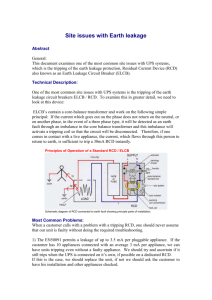South Africa – A pathfinder in earth leakage protection - CBI
advertisement
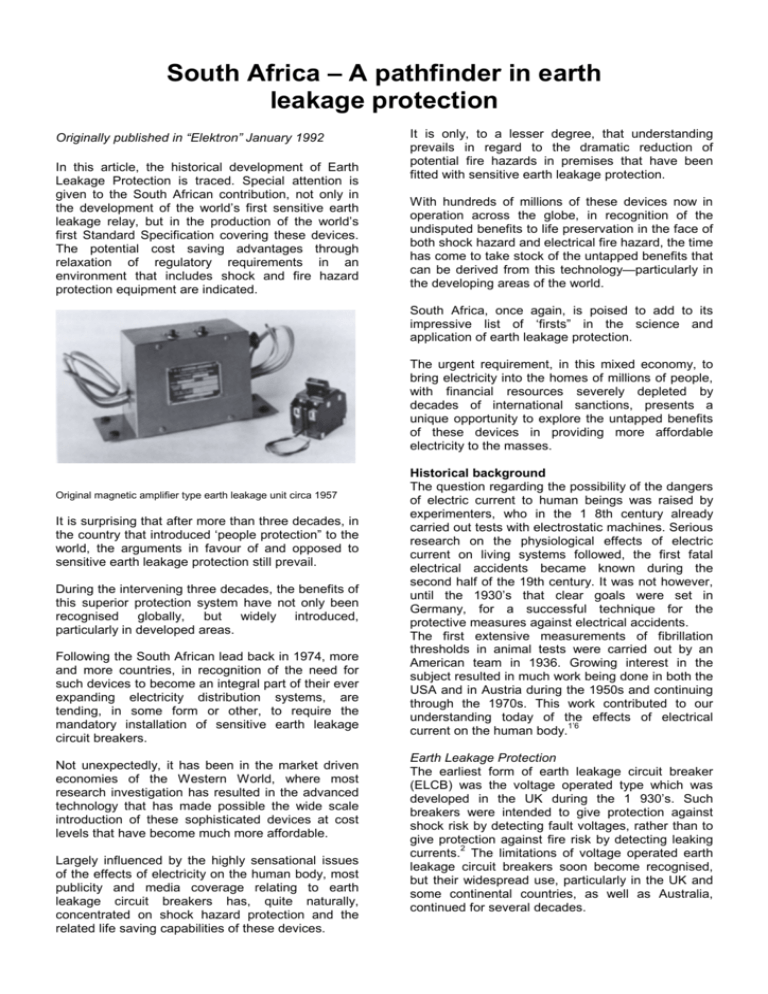
South Africa – A pathfinder in earth leakage protection Originally published in “Elektron” January 1992 In this article, the historical development of Earth Leakage Protection is traced. Special attention is given to the South African contribution, not only in the development of the world’s first sensitive earth leakage relay, but in the production of the world’s first Standard Specification covering these devices. The potential cost saving advantages through relaxation of regulatory requirements in an environment that includes shock and fire hazard protection equipment are indicated. It is only, to a lesser degree, that understanding prevails in regard to the dramatic reduction of potential fire hazards in premises that have been fitted with sensitive earth leakage protection. With hundreds of millions of these devices now in operation across the globe, in recognition of the undisputed benefits to life preservation in the face of both shock hazard and electrical fire hazard, the time has come to take stock of the untapped benefits that can be derived from this technology—particularly in the developing areas of the world. South Africa, once again, is poised to add to its impressive list of ‘firsts” in the science and application of earth leakage protection. The urgent requirement, in this mixed economy, to bring electricity into the homes of millions of people, with financial resources severely depleted by decades of international sanctions, presents a unique opportunity to explore the untapped benefits of these devices in providing more affordable electricity to the masses. Original magnetic amplifier type earth leakage unit circa 1957 It is surprising that after more than three decades, in the country that introduced ‘people protection” to the world, the arguments in favour of and opposed to sensitive earth leakage protection still prevail. During the intervening three decades, the benefits of this superior protection system have not only been recognised globally, but widely introduced, particularly in developed areas. Following the South African lead back in 1974, more and more countries, in recognition of the need for such devices to become an integral part of their ever expanding electricity distribution systems, are tending, in some form or other, to require the mandatory installation of sensitive earth leakage circuit breakers. Not unexpectedly, it has been in the market driven economies of the Western World, where most research investigation has resulted in the advanced technology that has made possible the wide scale introduction of these sophisticated devices at cost levels that have become much more affordable. Largely influenced by the highly sensational issues of the effects of electricity on the human body, most publicity and media coverage relating to earth leakage circuit breakers has, quite naturally, concentrated on shock hazard protection and the related life saving capabilities of these devices. Historical background The question regarding the possibility of the dangers of electric current to human beings was raised by experimenters, who in the 1 8th century already carried out tests with electrostatic machines. Serious research on the physiological effects of electric current on living systems followed, the first fatal electrical accidents became known during the second half of the 19th century. It was not however, until the 1930’s that clear goals were set in Germany, for a successful technique for the protective measures against electrical accidents. The first extensive measurements of fibrillation thresholds in animal tests were carried out by an American team in 1936. Growing interest in the subject resulted in much work being done in both the USA and in Austria during the 1950s and continuing through the 1970s. This work contributed to our understanding today of the effects of electrical 1’6 current on the human body. Earth Leakage Protection The earliest form of earth leakage circuit breaker (ELCB) was the voltage operated type which was developed in the UK during the 1 930’s. Such breakers were intended to give protection against shock risk by detecting fault voltages, rather than to give protection against fire risk by detecting leaking 2 currents. The limitations of voltage operated earth leakage circuit breakers soon become recognised, but their widespread use, particularly in the UK and some continental countries, as well as Australia, continued for several decades. Whilst the techniques of current balance earth leakage protection had been recognised for some years, it was not until the mid-1950’s that so called “sensitive” current balance devices were produced in West Germany. These “sensitive” devices had tripping sensitivities of 3 Amps down to 300 milliAmps. Parallel developments in France and Austria resulted in extensive installations during the 1 960’s, of core balance earth leakage circuit breakers having sensitivities of 500 mA and 300 mA, with 100 mA devices appearing in Austria. It was not until the latter half of the 1960’s that 30 mA sensitive devices started to make their appearance in France and Germany. The problem of the design and application of some form of protection against the hazard of fatal electric shock occurring accidentally on the 525 volt electrical distribution networks in the South African underground gold mining industry had received considerable attention during the 1950’s. This 3 prompted K A H Adams to present his paper in April 1957, describing and comparing the various systems available for this purpose. The tendency at that time was to use current operated earth leakage protection systems having sensitivities of the order of 10 Amperes, with the limit of sensitivity at that time believed to be 5 Amps. Sensitive earth leakage protection In recognition of the need to develop more sensitive current operated earth leakage devices, FWJ Electrical Industries, after experimenting with current transformer operated relays, ultimately, in 1956, produced a 250 mA sensitive device employing a cold cathode gas discharge tube, triggered from a core balance transformer via a simple electronic network. The importance of this development was quickly recognised and these devices rapidly received wide acceptance throughout the gold mining fraternity. A A Middlecote in his 1957 paper “Earth Leakage” concluded that “the soundest method of protection is by sensitive current balance relays”. People protection Current operated earth leakage protection was introduced into the South African gold mining industry, primarily to introduce some form of protection against fatal shock. Modern earth leakage protection circuit breaker The South African situation The foundations for earth leakage protection were laid by individual investigations, starting with L H L 4 Badham whose paper “Neutral Earthing and Earth Leakage Protection” was published in the Transactions of the South African Institute of Electrical Engineers in March 1940. This was followed up in a paper titled “Earth Leakage 5 Protection” by C A Martin in the SAIEE Transactions of June 1950. The work of Badham and Martin contributed largely to the “Code of Practice for Earth Leakage Protection for Mines for AC Circuits up to 660 Volts”, that was drawn up by the Prevention of Accidents Committee of the Transvaal Chamber of Mines and Published by the SAIEE in 1953. The studies of several researchers, including Dalziel 6 in the USA indicated however, that a current sensitivity of at least one order of magnitude better than the 250 mA devices being introduced into the mines would be necessary to realise meaningful “people protection”. Reliable, solid-state electronic components had not yet become commercially available in the mid 1950’s. (The transistor was first reported as a laboratory curiosity that came out of the Bell research laboratories in 1948). Though expensive and cumbersome, magnetic amplifier technologies were used by FWJ Electrical Industries to produce the world’s first high sensitivity current balance earth leakage protection device, having a tripping sensitivity of 20 mA. Following the unfortunate electrocution of a housewife who came into contact with a faulty standing lamp whilst polishing the floor, the owners of the mining property house commissioned FWJ Electrical Industries to accelerate their developments of these devices. These were first installed in the mining village of Stilfontein in the Western Transvaal in 1957. By 1958, 400 houses in Stilfontein had been fitted with these devices under a General Mining Corporation contract. The importance of this development was recognised by Heinemann Electric, South Africa, who introduced a solid state electronically operated “people protection” device during the early 1960’s, to be followed by voltage independent devices later that decade. For more than a decade, South Africa led the world in the production and application of high sensitivity core balance earth leakage protection devices, and was the first country in the world to require mandatory installation of earth leakage circuit breakers to all 220/250 Volt socket outlets. It is only in relatively recent times, that the massive resources of the Western world have matched and in some cases, surpassed these early South African developments. Standards and specifications One of the earliest Standard Specifications covering Earth Leakage Circuit Breakers, applied only to voltage operated devices, and appeared as British Standard BS 842 of 1939. This was subsequently revised in 1965, taking into account the relevant requirements of European Standard CEE.18. Preliminary discussions on a draft European Standard for current operated earth leakage circuit breakers started in 1962, and formed the basis for the corresponding British Standard “Current Operated Earth Leakage Circuit Breakers” This British Standard BS 4293 finally appeared in 1968, with CEE Specification CEE.27 only being published in October 1974. During the late 1960’s and early 1970’s, the CEE work and consequently the British Standard, concentrated on sensitivities of the order of 500 mA to 1000 mA without specifically precluding the use of higher sensitivity devices, which were finally recognised in the 1983 revision of BS 4293. A reference to protection by current operated core balance earth leakage protection devices was included in German National Standards during the late 1950’s, with the first VDE Specification that covered 30 mA sensitive devices appearing in the mid 1960’s, although 30 mA sensitive devices were not manufactured in Germany before 1966. French Standards covering high sensitivity core balance earth leakage circuit breakers appeared at the end of 1970 and into 1971 . These included: UTE 60 —1930 (general rules); NF C61 — 140; and NF C6i — 141; together with a practical installation guide UTE 15 —126. Across the Atlantic, in the USA, standardisation of these devices (known as Ground Fault Circuit Interrupters), after incorporation into the 1962 National Electric Code for swimming pool equipment, was only completed at the end of 1972 when UL943 followed the Standard for ground-fault relaying and sensing equipment (UL1053) that had been published earlier that year. The IEC in the meantime, had concentrated their efforts on “The effects of current passing through the human body”. These results finally appeared in IEC Publication 479 of 1974. The first IEC product standard covering these high sensitivity devices was published in 1 983 as Publication 755, titled “General Requirements for Residual Current Operated Protective Devices”. IEC 1008-1 , after many years of work by Committee TC23E, was published in 1990, with IEC 1009 due for publication shortly. IEC Committee 17B is currently completing work on Appendix B to Standard 947-2 which will cover requirements for core balance earth leakage protection incorporated into industrial type circuit breakers. The Australian Standard AS3190 was first published in 1974 with this original document being modelled on the South African Standard. Several revisions, including requirements peculiar to Australia, have since been published. The South African scene As a consequence of the 1957 introduction into the South African market of 20 milliamp sensitive current balance earth leakage protection devices, work was started in the early 1960’s by the South African Bureau of Standards on a National Standard. The document published in 1964— SABS 767, proved to be the world’s first product standard covering Core Balance Earth Leakage Protection Devices, in a market that was already accepting these devices in large numbers. Mandatory requirements in South Africa A March 1974 amendment to the Standard Regulations for the wiring of premises (“The Blue Book”) provided in regulation 226(B) for the installation of an earth leakage protection device in addition to any other mandatory requirements. Regulation 226(F) of that same amendment required as from September 1974, the mandatory installation of automatic earth leakage protection on all lighting and socket outlet circuits. The 1981 release of SABS 0142 — The Code of Practice for the Wiring of Premises, which superceded “The Blue Book” recognised that mandatory installation of these devices should, for other safety reasons, not include lighting circuits. 1972 and 1973 directives from the Rand and OFS undertaking of the Electricity Supply Commission required, in the intervening period, sensitive current balance earth leakage units complying with SABS 767, to be installed to cover the “whole installation” in domestic and rural installations, as well as on each separate distribution board for flats, shops and offices and every sub-distribution board in factories. Other countries The 16th edition of the lEE Wiring Rules for the UK makes provision for what they call “Residual Current Devices” but has mandatory requirements only in dangerous areas. On the other hand, the 1990 edition of the National Electric Code in the United States, has extended the mandatory requirement for installation of what they call “GFCI’s” on all socket outlets in bathrooms, garages and those located outdoors, as well as in kitchens whose outlets are within 1,8 m of a sink. In addition, there are a host of similar requirements for hotel and motel bathrooms and special locations such as pools, spas, crawl places, marinas, boathouses, construction sites, snow melting and deicing equipment, commercial garage workshops etc. Other countries to introduce the mandatory installation of core balance earth leakage circuit breakers in recent times include Australia and France as well as selective obligatory installation requirements in Germany, Austria and Switzerland. Sensitivity levels The intensive investigations into the impedance of the human body and the effect of electrical currents on the human body, continued over several decades into the 1980’s, finally culminating in an agreement for the basic tripping sensitivity level for these devices to ensure personnel protection. The level chosen was 30 milliamps, with a tolerance of +0,-5O % being applied. This resulted in a tripping sensitivity range of 15 mA through 30 mA. It is interesting to compare the close agreement of these values with the original South African choice of 20 mA +/- 25 % (i.e. 15 mA through 25 mA) that was established way back in 1957 and confirmed in SABS 767 of 1964. (Later revised to 30 mA). The sensitivity levels used in industry and mining applications vary widely, but the de facto final circuit protection sensitivity used in the South African mining industry is 250 mA. The 250 mA tripping sensitivity level found its origins way back in the 1950’s when investigations in South African gold mines suggested a worst case earth return bond impedance of 100 ohms. This value, when coupled to what was considered to be a safe touch voltage of 25 Volts, resulted in the 250 mA value. Technological Developments Protection through earthing The importance of protective earthing on low voltage electrical distribution systems, has been recognised for over half a century. Technological developments during the intervening period have not, other than in some special application areas, resulted in any change in this philosophy. What has changed however, lies with the assumption that overcurrent devices would always be operated by earth fault currents flowing through the earth return path. The major problem has always been that the magnitude of the earth fault current was, for a variety of reasons far lower than the theoretically anticipated levels. The advent of the moulded case circuit breaker, yielding far closer protection than earlier fusible devices, went a long way to improving this situation. The problem however, remained primarily with unpredictable and sometimes relatively high, earth return resistance paths. In low rainfall countries such as South Africa, this latter problem became only too obvious. Voltage operated earth leakage circuit breakers As their name implied, these devices were intended to provide protection by inserting in the supply, a circuit breaker, with an operating coil which would trip the breaker when the leakage current or voltage rise, due to leakage current, exceeded a predetermined safe value. These devices were particularly prone to damage by surge voltages such as those caused by lightning. Furthermore, operation could be impaired by extraneous parallel earths. Whilst reasonably good shock risk protection was provided, these devices provided little protection against fire risk. Voltage operated earth leakage circuit breakers are no longer manufactured or used. Current operated earth leakage protection devices The earliest current operated earth leakage protection devices utilised the residual currents from parallel connected current transformers to operate a relay protection device. Tripping sensitivity levels were dictated by the inherent mismatch between the parallel connected current transformers, and was in general, not less than many tens of amperes. Later developments used the core balance principle of detecting the vectorial unbalance between phase currents. Limitations in the availability of suitable magnetic materials and high sensitivity tripping devices, did not however allow for practical tripping levels below approximately 5 to 10 Amperes. The 1950’s developments in more sophisticated magnetic materials and electronic tube switching devices, saw tripping sensitivities drop to some hundreds of milliamperes as the end of that decade approached. In parallel, the very interesting South African adaptations of Second World War magnetic amplifier technology provided the first breakthrough into milliampere level tripping sensitivities. Sensitive core balance earth leakage circuit breakers With the interest of the world stimulated by the South African developments, the 1960’s saw the parallel development of two different forms of ELCBs. The first of these utilised solid state electronic components born out of the emerging space age. These developments were concentrated in the USA and in South Africa, with not insignificant interest coming from Europe. The Europeans however, in response to their almost paranoic fear of loss of supply voltage to electronic devices in the event of neutral breakage, began to concentrate on the development of high sensitivity permanent magnet tripping releases for ELCBs. South Africa used both technologies in parallel for several decades. However, increasing costs of imported magnetic components when coupled to the sometimes questionable stability of pure electromagnetic tripping systems, have resulted in a South African 1990’s swing to solid state electronic tripping devices, using all the advantages of modern technological developments. Even the “bogey” of broken neutral conductors has been overcome by providing alternative circuitry to the functional earth, whilst limiting the normal flow of current to earth to microampere levels. Pulsating DC earth faults The wider usage of electricity, coupled with the availability of many electronically controlled appliances, has in recent years led to the possibility of earth fault currents, which in addition to the AC component, contain a pulsating DC component. Such DC components may cause desensitisation of older generation ELCBs. The modern electronically operated ELCBs are not affected by the presence of such pulsating DC fault currents and meet all the proposed Standards performance requirements under such abnormal conditions. Operational considerations Legal consequences Prior to the advent of the extensive installation of sensitive earth leakage protection devices in South Africa, municipal and supply authority engineers were often faced with court appearances in regard to enquiries into electrical accidents. In addition to the question of the cost of time in attending these enquiries, this was for obvious reasons, an undesirable situation. Whilst accurate statistics into the incidence of low voltage electrical accidents are not easy to obtain, there is no doubt that the incidence of low voltage electrical accidents has reduced significantly over the past two decades. The argument against 10 A 1979 paper produced by the NBRI (National Building Research Institute) attempted to develop an argument against the mandatory installation of earth leakage circuit breakers (ELCBs) based primarily on the cost per life saved. Despite these arguments being strongly refuted in a 11 1980 NEERI report by J N Prak, a paper containing much of the 1 979 NBRI report details was again 12 presented by A Lap in 1987 under a slightly different guise. Comments and reaction to this latter paper indicated that the intervening seven years was possibly not long enough a period to gain subsequent support against the mandatory requirement covering ELCBs. Thirty five years of successful South African application of these devices appear to have established strong precedents in regard to electrical safety, independent of social or economic status. Statistics It is unfortunate that it is often not easy to obtain accurate and weighted statistics indicating the reduction in fatalities in the event of electrical accidents, as a result of the installation of ELCBs. 13 A recent report issued by the IEC’ however, does give some interesting information on the reduction of fatal electrical accidents over the past several decades, in Austria and Switzerland. Fig 1 shows a dramatic decrease in fatal electrical accidents in Austria following the introduction of 100 mA sensitive devices in 1960. A curve extrapolated from prior 1960 conditions indicates a trend of six times more electrocutions being possible had these devices not been installed. Shock hazards A directly lethal shock is almost invariably associated with the passage of current through the victim’s body, arising from a line to line or line to neutral shock. Almost invariably, there is an associated current through the body to earth and this is the fundamental reason leading to tripping of ELCBs. Fig 2 shows an even more dramatic reduction in fatal electrical accidents on building sites, following the mandatory introduction of 30 mA sensitive devices on building sites in Switzerland in 1976. Provided these devices are sufficiently rapid in operation, they can provide complete protection against the risk of any shock being directly lethal, without preventing the electrical shock itself. The provision of 30 mA sensitive ELCBs is however in no way a replacement for the provision of good and solid earthing on the electrical installation. In most cases developing electrical faults, in the presence of a good earth, will be automatically detected and disconnected by the ELCB. With a good electrical distribution system, earthing in itself, will generally restrict the degree to which voltage can appear for example on accessible metalwork. The ELCB in this sense is providing socalled “Indirect Protection”. The high sensitivity of ELCB’s however, does allow for reliable operation even in the event of relatively high earth return resistance paths. This implies the provision of “Direct Protection”, particularly on electrical distribution systems having a solidly earthed neutral. Fig 1. Fatal low voltage accidents in Austria Fire hazards Electrical fires associated with overheating due to overloading of the installation, or of electrical equipment connected to the installation, should, in normal circumstances be prevented through detection of the overload by the installed overcurrent protective devices. If however, the impedance of the fault restricts the resultant current to less than the rated current of the circuit, such a fault would not be detected by conventional overcurrent protective devices. Hence, a low current that is arcing or tracking between conductors does present a different problem. Fig 2. Average annual fatal electrical accidents on building sites in Switzerland Since such faults will invariably involve some flow of current to earth, the use of sensitive earth leakage protection devices can make a very significant contribution to the elimination of fire risks. Mass electrification There is an urgent need to provide electricity to millions of homes in South Africa. Economic considerations dictate that this electrification be done at the lowest possible cost so that more homes can be electrified with limited funds, in the absence of foreign investment. The socio-political implications of relating the cost of saving a life against the possibility of electrocution simply to provide more electricity, could be serious. For this reason the elimination of proven devices that offer a high level of protection against both shock and fire hazards for marginal cost reasons only, is not a real option, despite such reactions being economically correct and understandable. Supply voltage considerations 15 A school of thought exists in South Africa that suggests that the provision of sensitive earth leakage protection could be dispensed with by changing the distribution system from the existing 400/231 three phase grounded neutral system, to a 110-0-110 Volt single phase, centre point earthed system similar to that used in the USA, but providing 220 Volts across the outer lines. The theory, is that with a maximum of 110 Volts to earth, no shock hazard would exist. This theory remains questionable, particularly in consideration of the extensive studies into the effects of electrical currents on the human body and confirmed in recent IEC reports. Furthermore, the extensive and ever increasing mandatory requirements for extremely high sensitivity devices in the USA (6 mA) must be indicative of the value and need for such devices. The reduction of electrical fire risk hazards are a further factor that cannot be ignored, and could possibly be aggravated by lower supply voltages under conditions of high impedance faults. Test device All ELCBs are provided with a test device. Users and consumers are encouraged to operate this test device often and regularly as an assurance into the continuing long term reliable operation of these important electrical protection units. New opportunities South Africa, over the coming decade, faces a tremendous challenge in the provision of millions of homes and their electrification. The economic constraints associated with this commitment, present a unique opportunity to develop new techniques and methodologies in achieving this end. There is no doubt that in such a climate, some degree of relaxation of existing standards may have to be considered for pure economic reasons. One example of such relaxation that has already taken place is the introduction of small Power Distribution units, or more commonly known as “Ready Boards” as covered in NRS Specification 019 of 1991. These devices approach the most fundamental requirement for the provision of electricity into a dwelling unit. The degree as to which the supply of electricity derived from these devices is either used or misused is virtually uncontrollable. While electricity in developed societies has been shown to be a clean, safe and economic source of energy, the potential hazards of this energy source if misused, cannot be ignored. In a developing society, the probabilities of misuse are real. Examples may include circuit overloading involving multiple extensions. Such extensions (of uncontrolled length) may be made by using low cost underrated conductors having inadequate insulation properties. It will not be possible, nor desirable or practical to introduce regulations in an attempt to control such extensions. Notwithstanding these sentiments, it would be morally wrong to ignore the possibilities of either shock hazard or fire hazard that might arise from misuse. If it were possible to include in the electrical installation a device that would allow for basically uncontrolled use of the electrical energy source, and still provide automatic detection and prevention of a pending or real hazardous situation, such a device would approach the ideal. Such a device not only exists, but has evolved over the past several decades, into a reliable and accepted piece of equipment. It is the Earth Leakage Circuit Breaker which provides not only sensitive earth leakage protection, but also overload and short circuit protection as well as circuit safety disconnect features and is covered by SABS 767 and SABS 156. Cost saving opportunities There is no doubt that the availability of. electricity generates comforts and labour saving opportunities that might previously not have been available. Many theorists relate even the growth in affluence to the availability of electricity. Even a limited growth in affluence will in all probability generate the desire for more labour saving and entertainment providing electrical appliances. Allied to this, the pride of home ownership will in all likelihood, increase the desire for a more permanent electrical installation to provide power to these appliances in a possibly extended dwelling unit. The actual wiring installation, in accordance with existing regulations, could involve significant costs. The presence of a permanently installed fault detection device, such as an ELCB, having been proved effective for unauthorised wiring, presents some unique opportunities for cost savings on conductor sizes, insulation requirements, as well as on the installation of the wiring and associated outlets of authorised wiring. Faults on long cables The problem of short circuit faults in cables some hundreds of metres from the energy source, has always presented a serious protection problem, since at some point, short circuit currents may not be much greater than full load currents. This problem could be exacerbated if the fault were not a bolted short circuit but an arcing fault. The majority of cable faults in all probability will involve earth during some stage of the development of the fault. Within the limitations of circuit protection technology that is currently available, it would appear that the provision of sensitive earth leakage protection may possibly be the only practical solution. Whilst such situations may be more common in underground mining installations, they are not inconceivable in surface distribution. Long lengths of unauthorised extensions using very light conductor could result in a similar low level fault condition with an associated fire risk if not quickly detected and cleared. Conclusions This paper has traced the development of earth leakage protection and indicated the very real need for such protection against both shock hazard and fire risk. The major South African contribution in the development and application of sensitive earth leakage protection circuit breakers has been highlighted. Having grown out of an identified need in the underground gold mining industry, South Africa led the world in not only developing ELCBs but in publishing the world’s first Standard Specification covering these devices, and also in mandating their use in both residential and industrial installations. Only injurious or fatal electrical accidents are reported. It is impossible to determine how many lives have been saved by ELCB’s since their first installation three and one half decades ago It would be frightening to contemplate the consequences of uncontrolled wiring and electricity usage in developing environments that were not provided with such protection devices. South Africa is now poised to display to the world how electricity can be supplied to millions of dwellings in a third world environment under restrictive economic resources, whilst maintaining first world electrical protection criteria. References 1. About the effects of electrical current on the human body. By G Biegelmeier — April 1977. 2. World-wide design trends in earth leakage protective devices. By J Rickwood — April 1976. 3. Protection systems against the hazards of electric shock in mines. By K A H Adams—April 1957. 4. Neutral earthing and earth leakage protection. By L H L Badham — March 1940. 5. Earth leakage protection. By C A Martin — June 1950. 6. The effects of electric shock on man. By Charles F Dalziel — May 1956. 7. Earth Leakage. By A A Middlecote — April 1957. 8. International trends in earth leakage protection. By J A Robbins — September/October 1967. 9. Conflicts in international moves to rationalise Standards. By J A Robbins — February 1 971. 10. NBRI Report on ELCB’s — 1979. 11. NEERI—Electric power report. By J N Prak — 1980. 12. The safety aspects of prefabricated wiring systems in housing. By A Lap — February 1987. 13. IEC document 64(Secretariat)559 — A new philosophy of protection against electric shock. 14. Protection against earth leakage shock and fire hazards. By J A Robbins — 1976. 15. An international review of electrification in developing countries. By C E Dingley — March 1990.

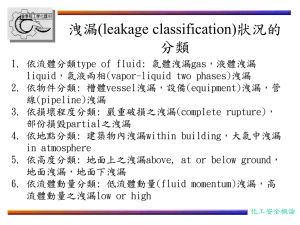
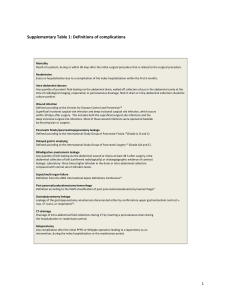
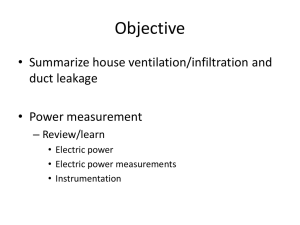
![Section 01669/Leakage Test of Hydraulic Structures [spec]](http://s3.studylib.net/store/data/007419897_1-1b5e9897de2aef63720e2aa5ff669e8a-300x300.png)
